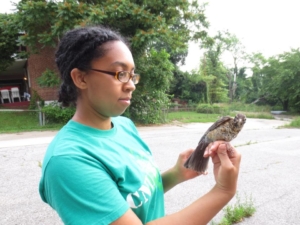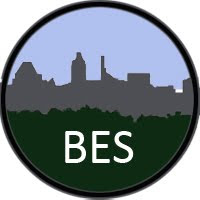Birding While Black in Baltimore – part 2
Today our guest blogger is Dr. Ela-Sita Carpenter. She is a Baltimore Ecosystem Study graduate student alumni and #BlackBirdersWeek participant.
I feel immensely lucky to be a birder, life-long resident, and urban ecologist in Baltimore. One of my earliest bird memories was watching my dad feed birds that visited our backyard (long before I knew it wasn’t okay to feed them bread!). My first moment of awe with birds as a kid was seeing a male American Goldfinch visit a sunflower that I had planted – it was so stunning and magical!
After leaving to go to college, get a Master’s degree, and do some wildlife research gigs in Virginia and Nevada, I returned to Baltimore and spotted a volunteer bird position. It seemed easy; there couldn’t be that many species in a city. (Note: BES research has recorded 98 unique species and more remain to be identified). Alongside my colleague & friend Christine Brodsky, I spent the summer 2013 traveling around the city locating bird nests, surveying birds, and even learning to handle and band them. At one heavily forested site, I was fortunate enough to have my camera on me as I spotted a young Barred owl! Birds of prey, warblers, woodpeckers, and other birds surprised me with their presence in vacant lots.

I spent several years as the lead for Baltimore Ecosystem Study’s (BES) long-term bird monitoring program. We surveyed birds at 132 points across the city to see how changes in neighborhoods over time affect bird species composition, distribution, and abundance. Some points were in ‘dangerous’ neighborhoods. However, the wealthy, predominantly white, ‘safe’ parts of the city made me a different type of anxious. In those spaces, I hesitated to use binoculars to ID birds – could I be mistaken for someone scouting for a place to rob? Would a cop believe me if I said I was doing bird research – something that is predominantly done by white people? Would my BES research shirt be enough to convince them? Having a script in my head to tell cops or ‘concerned’ neighbors (just in case) was something I did regularly.
This is why I was happy to participate in Black Birders Week, created by a group I am honored to be involved with, BlackAFinSTEM. This week-long social media event was motivated by the incident that happened to Christian Cooper during an outing in Central Park. During this event we wanted to accomplish several things:
· Increase the visibility of and uplift Black birders to show that this activity is for everyone
· Share our experiences as Black birders so others understand why we may sometimes feel uncomfortable outdoors, and
· Advocate for increased diversity in the birding and outdoors communities.
Listen to our stories on Twitter and Instagram, and ask yourself what actions you and your organizations can take to make the outdoors, safe, enjoyable, and accessible to everyone.





